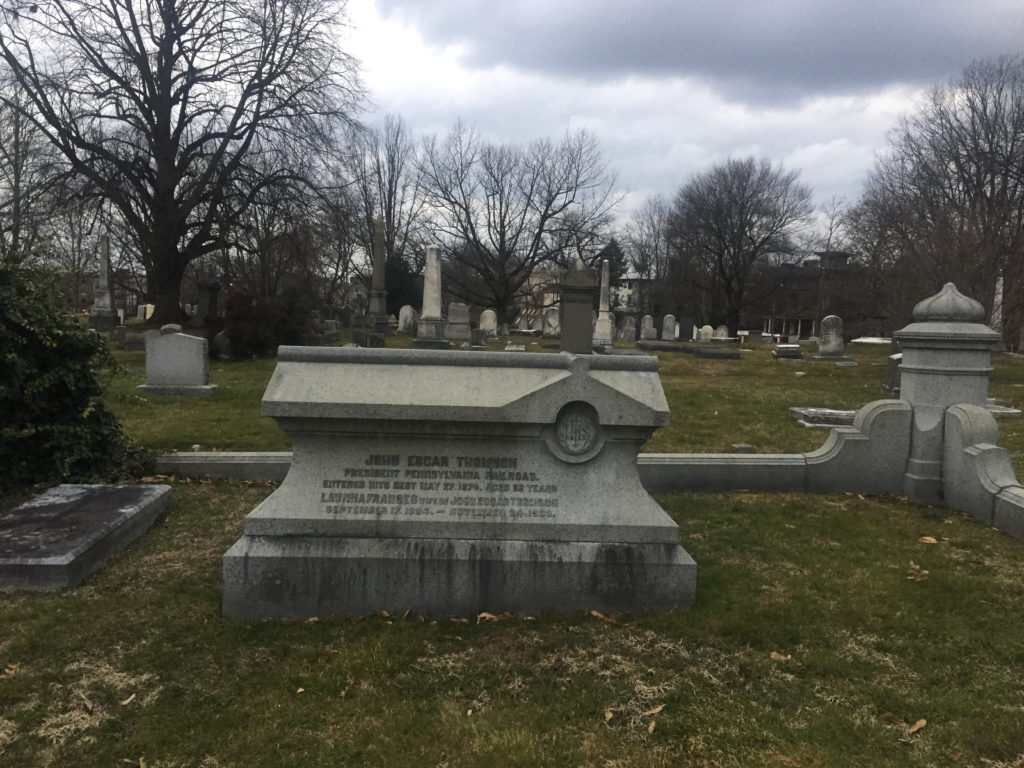Erik Visits an American Grave, Part 916
This is the grave of John Edgar Thomson.

Born in 1808 in Springfield, Pennsylvania, J. Edgar Thomson grew up in an engineering family of the Transportation Revolution. His father was an engineer who was a key figure in the canal building craze after the opening of the Erie Canal and also did some railroad work. The son followed the father. In fact, the father took young John along with him during his work and taught him the trade from a young age. So Thomson was able to start working on his at the age of 19 on railroad survey crews. In 1832, he headed to Britain to learn about railroads there, which was at the time the world’s leader in the technology.
When Thomson returned from England, he was already one of the nation’s most skilled railroad engineers. In 1834, the Georgia Railroad hired him as its chief engineer. He worked on that for over decade and created perhaps the best rail system in the South to that time. By 1845, it was the longest railroad in the world, stretching from Augusta to what is today Atlanta, a total of 173 miles.
With this success, Thomson was a man in demand. The state of Pennsylvania hired him. That state had invested heavily in transportation infrastructure but not with a lot of success. The state’s geography was a problem. While not particularly high in elevation, the state is extremely mountainous and it was hard to get anywhere efficiently. It was also expensive and technologically challenging. It was worried about the economic future of the state if it couldn’t get decent transportation built. That’s why the state brought Thomson on at the extremely high salary of $5,000 a year. What made Thomson famous and remembered today is his engineering of the “Horseshoe Curve” in central Pennsylvania, an enormous technological innovation that basically created the possibility for train travel across rugged mountainous areas. This is so historically important that it is actually a national park today–the Allegheny Portage Railroad National Historic Site is effectively the National Park Service site for the Transportation Revolution and is actually pretty interesting if you are in central Pennsylvania. Plus it’s a nice place to walk around these days, which it most certainly not when the railroad was in its heyday. By 1854, the railroad connected Pittsburgh and Philadelphia and ensured that the state remained an economic power in the nation.
In 1852, Thomson became president of the Pennsylvania Railroad, moving into being a railroad executive more than an engineer. That was where the money was anyway. He was a vicious capitalist heavily focused on efficiency, which meant monopoly. As I’ve stated many times, the corruption and dirty dealings of the Gilded Age was significantly enhanced and sped up by the Civil War, but all the pieces were already there as capitalism developed in the 1850s. As the 1860 and early 1870s went on, Thomson expanded the business not only to be basically a monopoly in the state of Pennsylvania, but into the Midwest as well, building significantly in states such as Ohio and Indiana. He also purchased the Pittsburgh, Cincinnati, Chicago, and St. Louis, expanding his empire through the region.
What did make Thomson different than other railroad capitalists was competence. He didn’t let his personal greed get in the way of sound business decisions, which plagued Jay Cooke and Jay Gould and other rail barons. In other words, those guys would and did send the American economy into the gutter through their corruption and risky investments. But Thomson saw through them and wouldn’t invest with them. That meant when the Panic of 1873 happened, he didn’t lose all his money like Cooke did, though he certainly took a hit. But the company remained stable. If you dig deeper, he certainly did have his share of sketchy investments, so it’s comparative, but for the time, this statement holds.
Of course, none of this meant that Thomson was pro-worker. Although he was not around when his longtime partner Thomas Alexander Scott urged the military give workers a diet of bullets during the Great Railroad Strike of 1877, he certainly would have agreed. For men like Thomson and Scott, the death of workers on the railroads, the way they just rammed through cities without safety precautions, even the frequent accidents that killed passengers, all of this was just the cost of doing business and the government had no right to say otherwise and neither did the affected people. He did leave a lot of his fortune to take care of the children of dead workers, which was necessary because there were so many dead workers. So he was happy to play the paternalist, but that was the limit of it. Actually doing things to stop workers from dying was not going to happen.
Thomson died in 1874. He was 66 years old.
John Edgar Thomson is buried in Woodlands Cemetery, Philadelphia, Pennsylvania.


